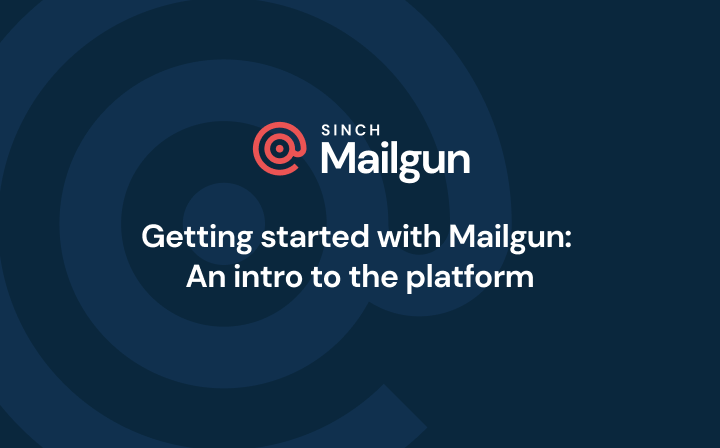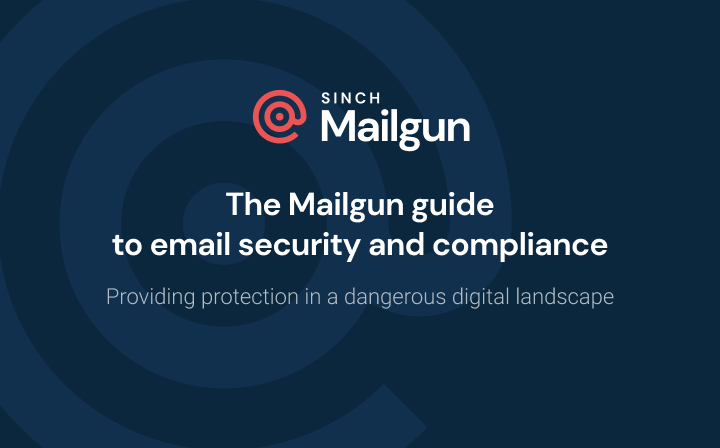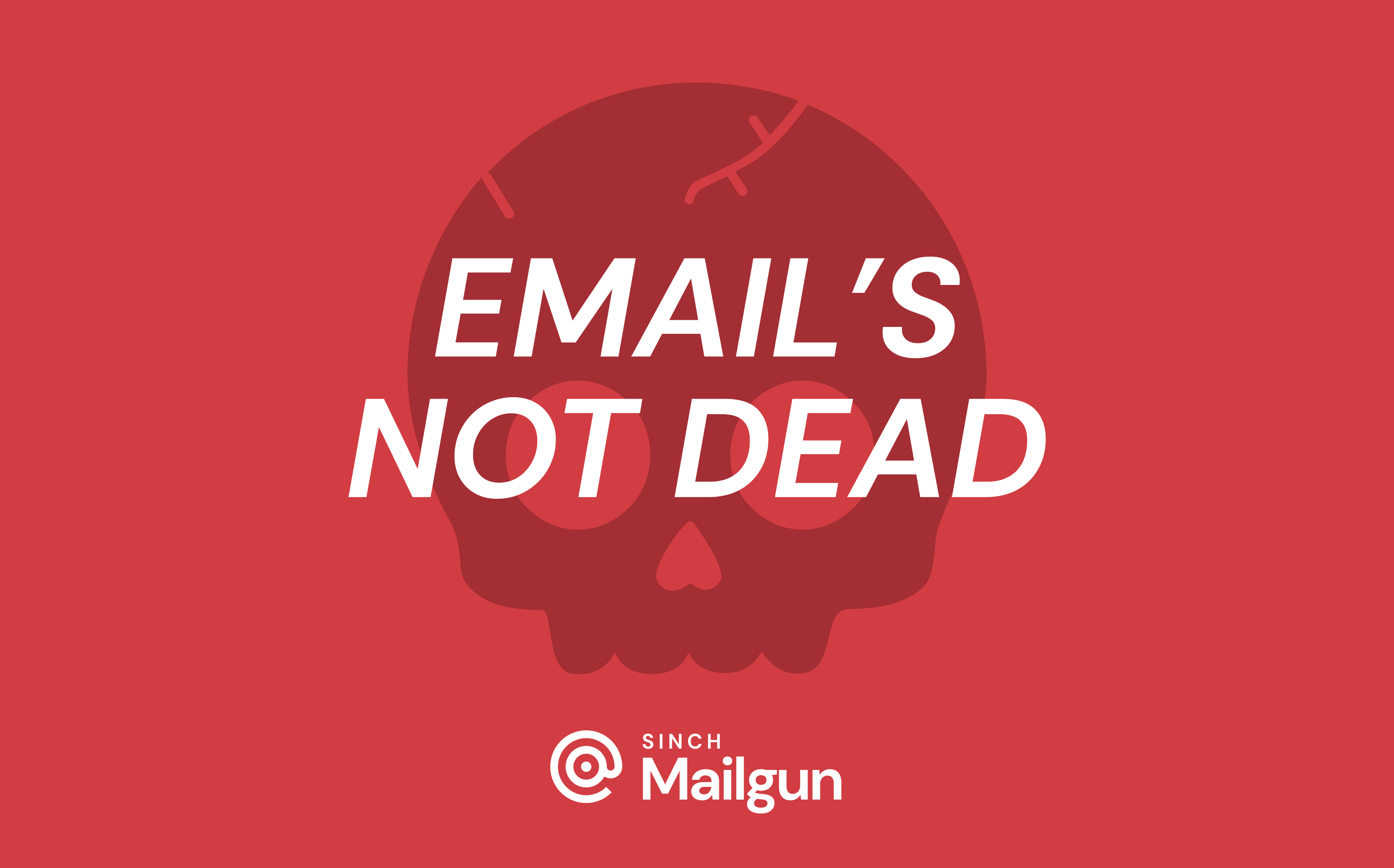Podcasts
Sending a more relevant message with omnichannel communication
Email’s Not Dead: Season 1, Episode 5
Home
The Mailgun Resource Center
Podcasts
Sending a more relevant message with omnichannel communication
Sending a more relevant message with omnichannel communication
Email's Not Dead
About this episode:
Omnichannel marketing and email, how does it all fit in? Jonathan and Eric sat down with co-founder and CEO of Omnisend, Rytis Lauris, to talk about transactional and marketing messages leading into 2020, and how you need to look towards other types of email communication to better reach your customers. Learn how it trickles down and how it’s all about the engagement in our latest episode.
PUBLISHED ON
Meet your presenters

Jonathan Torres
Manager of the TAM team at Sinch Mailgun

Eric Trinidad
Technical Account Manager II at Sinch Mailgun

Rytis Lauris
CEO at Omnisend
transcript
Email’s Not Dead – S1, E5: Sending a more relevant message with omnichannel communication
Overview
00:00:23 - Meet Rytis Lauris, CEO of Omnisend
00:05:17 - The beginning of Omnisend
00:09:21 - Why omnichannel marketing needs to be a part of your program 00:15:10 - Is this opted in content?
00:00:05
Eric Trinidad: Welcome to Email's Not Dead. My name is Eric Trinidad and with me, as always, is...
00:00:09
Jonathan Torres: Jonathan Torres.
00:00:11
Eric Trinidad: Yeah. There you go.
00:00:11
Jonathan Torres: Thank you!
00:00:12
Eric Trinidad: We're technical account managers here at Mailgun and we're here to talk to you about email, marketing, deliverability, all the things. And we have a very special guest this week.
00:00:23
Jonathan Torres: Yeah, we do.
00:00:23
Eric Trinidad: Yeah. Rytis Lauris, co-founder and CEO.
00:00:28
Rytis Lauris: Yeah, that's right. Hello guys, hi guys.
00:00:29
Eric Trinidad: Of Omnisend. How are you doing today Rytis?
00:00:34
Rytis Lauris: Yeah, I'm great. Yeah. Yeah. Having, I mean, already like a great conversation with you guys. You know, before we started recording we had a lot of fun already. So the day is bright.
00:00:43
Jonathan Torres: Yeah! Thank you.
00:00:45
Eric Trinidad: I know we're... we're in an office building right now overlooking, you know, the little city of San Antonio and the sun's rising as the sun is setting kind of on your side. So, you know, we're on different sides of the globe and taking advantage of all the technology that we have. We're doing the audio version today and I feel very overdressed. Maybe an overdressed dad in my T-shirt. You can see me Rytis, but ya’ll are very comfortable. I'm very jealous.
00:01:09
Jonathan Torres: Yeah, yeah. I don't know why you dress that way. It's OK.
00:01:12
Eric Trinidad: Yeah, I'm sorry. Well, you know, I wanted to be a professional, you know. You know, I don't know how professional pineapple t shirt button ups are, but you know, here we are.
00:01:22
Rytis Lauris: That's, that's very important, you know, to feel professional and to be comfortable.
00:01:26
Eric Trinidad: Yeah. Dress for the job.
00:01:27
Rytis Lauris: Whatever, works.
00:01:31
Eric Trinidad: Dress for the job I want, I guess pineapple distributor.
00:01:33
Jonathan Torres: Yeah. Yeah that works too. But yeah, it's definitely one of those things that in our line of business we've got to be sure that we're prepared for anything also. So that's why I go t-shirt and shorts, because you never know when you have to run across the office for something.
00:01:46
Eric Trinidad: Yeah. Because you've got to be flexible, you know, you don't know what hurdles you're going to run into throughout the day. But we're not here to talk about dress codes. We are here to talk about Omnisend. One of our great partners and wanted to bring you on today, Rytis, to kind of talk about, you know, all things and Omnisend and how y'all utilize us and how you're successful. So let's kind of get going. Can you explain – what is Omnisend?
00:02:12
Rytis Lauris: Yeah. So thank you guys for inviting, it's really a pleasure to be here to talk to you. As well it's a pleasure to have you as our strategic partners, it's not a secret. We do use Mailgun services for delivering all that. All the emails here at Omnisend. Yeah. So what Omnisend is Omnisend is a omni channel marketing automation tool with email as a center of that. And we help all of the online retailers, all the online commerce businesses to retain their customers, to communicate with their existing customer base. So what do I mean by that? Like someone has already purchased in the past or maybe someone has abandoned a cart or etc. So you have a permission to communicate with existing customers or prospective customers who have already subscribed and left their email or push notification or like text messages like opt in. And have subscribed to our list and you start communicating with them. And the key goal here is to retain your existing customers, to invite them back and to send the relevant messages for other people at the relevant time. And we're adding a relevant channel on top of those three.
00:03:24
Jonathan Torres: Yeah, great. Yeah, that's something that we've harped on this podcast. I think more than anything else is, like, the engagement piece, like making sure that you're one... relevant messages I think is super important. Like that's something that we always talk about. And then yeah. Then that engagement piece, like making sure that somebody is wanting stuff that you see that they're wanting things. And I think that's so important in today's email world because as senders, that should be important to us. But then as far as services like try to build out and protect their users from unwanted messages, that engagement piece becomes so much more important because they are also tracking that information. So like the big email recipient locations, so like Gmail and Yahoo and Microsoft services, like all that kind of stuff.
00:04:06
Rytis Lauris: I completely agree here. And one of like advantages, Omnisend advantages is like you have a lot of data of your customer behavior. So we do synchronize both, all the backend data like past behavior, and we do track a lot of your visitors behavior on side. And by combining those two really helps us to provide the best segmentation, the best automation triggers and then to send relevant email. So the message is for the recipient. So people really tell a lot and their behavior tells a lot about, what kind of people, what interests do they have, etc., and combining all this data, analyzing it and putting the right segments right triggers in place really enables us and our customers to communicate better with their existing customer base, which is very important.
00:04:56
Jonathan Torres: Yeah, yeah. I mean, is that kind of… I don't know what, it kind of leads into a little of the conversation of like, is that where Omnisend kind of came out of, is that need for that kind of thing? Like I mean, I guess more of just from your side, like, if you can explain a little bit like why or how Omnisend came to being? Like how you saw this was important and where you kind of wanted to channel things into.
00:05:17
Rytis Lauris: Yeah. So the story was actually Omnisend is a spinoff from a digital marketing agency, so we used it to serve our customers and, like, do website development, Facebook, Facebook apps, et cetera, and digital marketing, including email marketing at that time for some of e-commerce customers. And what we've seen about the real specific both needs and capabilities for e-commerce, e-commerce businesses, that we have more data comparing to just a generic website. And they have online transactions. That's like one hundred percent of their transactions are happening online. So combining these two, like having more data, having all the transactional data on top of that really allows you to do better to automate a lot, which really removes a lot of hassle, need to send the bulk campaigns, which are not always relevant, you know, and etc.. So, yeah, we saw this opportunity and we launched the product five years ago. So it's already like, technically it's five years for the company, but a couple of first years we didn't manage to earn money from that.
00:06:30
Jonathan Torres: That happens a lot.
00:06:31
Rytis Lauris: Yeah, it took us a while to really understand what our customers need, although we kind of had a rough understanding that there is a specific need, there is a niche for us and that we can help with those online businesses. But, yeah, it still took us a while to understand what the exact needs and how can we help them to retain their customers better. Yeah, so that was the story. And you know, we have launched this product and we saw that for sure as an opportunity and there is a market need here. And e-commerce by itself, it's growing like 20 to 25 percent globally. So a lot of new players I ever really knew. New players are coming to market. All of those traditional offline businesses are coming to online sales. And we strongly believe that in the future, everything's going to be like, you know, online businesses.
00:07:21
Jonathan Torres: Right. At least connected somehow. Like, that's one of the things. I mean, you see everything now, like I know everything from I get emails from all over the place. I know that at the very least, I know that there's an email coming into me from everything from.
00:07:38
Eric Trinidad: Go ahead.
00:07:39
Jonathan Torres: Like I'm thinking like, everything from, like, credit card payments and, you know, engagement with credit card companies to dry cleaners to I mean, like, I don't think I'd do anything as… at least the amount of physical things I have to do. I will do. I'll do everything online if I can do everything online from shopping to man or whatever.
00:08:00
Rytis Lauris: Like lawyers.
00:08:01
Jonathan Torres: Right? Yes.
00:08:01
Rytis Lauris: They have, like, a very traditional profession and like back in the day and still now the traditional behavior, when you interact with the lawyer, you just, you know, give a call like you exchange a lot of emails, et cetera. But there are a lot of companies... like companies which already provide online services instead of, like, exchanging lots of emails to just pay for the draft of a contract, which is done lot ends and it's already purely online transaction. And they form a template you pay with your credit card, you download and you give consent to communicate. And this is a great opportunity for that business to start talking with an already existing customer.
00:08:43
Eric Trinidad: Yeah, no, that'd be great to get a lot of those. I know those lawyer ads. If we can get less and less of those on TV and move those online to where they're targeted to who they need to talk to, then they'd be perfect. I can get back to my, you know, daytime court drama.
00:08:58
Jonathan Torres: It just feels a lot less like yelling sometimes. Unless you're doing an email in all caps, it's a lot less yelling. You know if you get a text message in all caps. That's a problem.
00:09:11
Eric Trinidad: You mentioned, you know, Facebook and SMS messaging. What are the other types of channels or how many different channels are there with Omnisend?
00:09:21
Rytis Lauris: Yeah. So a part of email which is a really important channel. So we strongly believe that the future of commerce in general is omnichannel, but that means that you will be capable as an end customer to buy, to buy every way what? So like on social media, offline and online, via text messages, via all the chats, et cetera. Careful marketing should become omnichannel as well. So apart from email we do have Facebook Messenger messages, WhatsApp messages, Viber messages, text messages, SMS, MMS. Yeah, so all those and push notifications. So all those channels are in place and you can, you know, use them while communicating with your customer in the most effective way.
00:10:10
Eric Trinidad: And then do they first get these notifications or at least is it, like, tiered, like where the first level is email, where you get the permission and it’s included, all of that?
00:10:19
Rytis Lauris: So it's up to marketers. So it's really up to you how you do it. So first. Good thing is really... so some of you allow your customers to choose which is the most preferred channel. So email is being chosen like most cases. But part of that, some of the people, they prefer WhatsApp, some people, text messages, some of other people, they prefer web push notifications. So will you allow your customers to choose what is the most preferred channel which is already beneficial both for your customers and for you or for your business, as if that means that you kind of have the best option to keep a dialog with your customers. So it's one thing. Another thing is really how you combine that is it's really up to you so you can do it, let's say, in the most cost effective way. So you start with an email which is the most cost effective channel. If you have consent and permission to send email messages, then you follow up with, let's say, web push notifications, which are again, relatively low cost channel, then you start adding more and more expensive channels like text messages, WhatsApp... and like ending up with synchronization of your data to run retargeting campaigns via Google or Facebook ads, which is the most expensive way to really retain your customers. So the beauty here is really, as we are, omnichannel tools. We allow our customers to, and our customers like marketers, to add all those channels on a single customer flow. That means that you are serving instead of, like, campaign point of view. We have a lifecycle point of view that, you know, we have different triggers of what the customer is doing on the Web, on their website, on that online store. And based on that, you can take different channels to communicate, which is the best at that specific situation or like, you know, just do one after another if the first one is being ignored. So let's say you send email. If email is not being opened, or only when you send a text message. Otherwise, you stop the campaign then or, let's say, you continue with an email sequence if a person is engaging with you for an email channel.
00:12:31
Jonathan Torres: That's great!
00:12:34
Eric Trinidad: I was really trying hard not to say right. I was like, OK, I got to move to awesome. But that's exactly what he said.
00:12:43
Jonathan Torres: Yeah, I mean that's appropriate. Like it's, it feels like that's like everybody said it feels like only natural, like this is exactly what you'd want to happen for people who are trying to get information to you. Like, I already get super excited when there's just the option of like, oh, text message or email. Like even just having those two is great. But yeah, there's more options out there. Like I say, the more the merrier. That's always great.
00:13:07
Rytis Lauris: I know it's all about like the ultimate goal is to create great customer experience, but customer experience is really like, having those options in place and like, really playing around with those different channels really helps brands to integrate that great customer experience, which is the most important thing nowadays.
00:13:27
Eric Trinidad: Yeah. And of course, if they're engaging, that only gets, you know, the more information on the market that you're trying to hit, you know, the more they answer, the more they talk. We talk about this all the time about making sure that we... the email that, you know, you're talking to the users that want to receive your message and regardless of where it goes, you know, they're going to find it and they're going to want to, you know, give you that feedback. They're going to look for your item.
00:13:48
Rytis Lauris: Yeah. And you guys talk a lot about spam, which is really the case. And it's really great that you're addressing this topic because this is still an issue. So it's again, one of the ways really to kind of create more relevance and to avoid really expanding and not to become intrusive in your, let's say, email communication and you augmenting email with other channels. It's a way to, you know, really to be more targeted and to be more specific in communication. And you get all the upsides as well as like, you know, your messages, including email going to primary inbox instead of going to spam because you really do well triggered well selected communication, which helps a lot to do and increase the overall communication quality, including all the technical aspects as well.
00:14:37
Jonathan Torres: Right? Yeah. And I mean, when we start getting into that, into the subject of spam and technical aspects of everything, is there anything that you guys do to kind of help? I mean, users manage the permissions to do all the stuff because I'm sure I know a little well, we know a lot about permissions when it's an email, but I know a little bit about, you know, kind of permissions of what it takes for sending like text message things. So I know there's a few requirements as far as, like, giving them an option to opt out and those things from the text message side of things. Like do you have anything you can talk to about that, like what it takes to do all that? And then how do you help your customers, you know, manage all that.
00:15:10
Rytis Lauris: Yeah sure. As a general rule it is absolutely the same. So it's all opt in based consent. So it doesn't matter which channel you have to have permission from, from your subscribers. So if it's email or text message or Facebook messenger message, so you have to ask for permission and then customers opt in, only then you can send promotional messages alongside, you can do some transactional messages, which can be a little bit, you know, with some promotion message on top as well. So what do I mean by that? So let's say you are sending, like, pure transactional messages that your parcel has been dispatched or that we have received your payment. So like, 80 percent of the message is really transactional. But you can add just a little bit on top of that. By the way, there is a discount code for your next purchase, which is a valid agreement. So you really, like, provide really valuable information for the customer, which is definitely very important. And you add something on top which just like, you know, slightly slightly promotional. So in those cases you can send without a consent, which the messages are really related with some transactions, otherwise fall like mobile campaigns or even triggered campaigns. But you need to have the content. So it's exactly the same as it is with emails. Yeah. So just, you know, subscriber, subscriber, you have to have content. And as you know, being from Europe, we are even more, more concerned of that because Europe is more strict, of course, like California you know is.
00:16:46
Eric Trinidad: It's getting up there, too. Yeah.
00:16:52
Rytis Lauris: Yeah. It's, it’s interaction. So it's like California law is very, very similar to like European GDPR. So we were kind of ready for that a couple of years ago and then so yeah, it's a matter of a challenge. You have to follow best practices and you have to have consent.
00:17:11
Jonathan Torres: Right. And then we always, I don't know from our side, we always tell people if you, if you're already having to plan for, like, GDPR and CCPA, then. Yeah. Like, well, might as well make your whole subscriber base, you know, follow the same kind of rules and make sure that you're following these best practices with everybody. That way, you know, if something changes, I mean, you never know, you know, something like the CCPA, which is the one for California, you know, spreads out and more states in the United States start adopting that, then. Yeah, then that's something that everybody's going to have to adhere to. If there's another market that you participate in, whether it be Australia or maybe somewhere in Asia, if they're doing the same kind of things and they adopt that same kind of law, then you're ready to go. If everybody is just doing the same thing for everybody, for all their subscriber base.
00:17:56
Rytis Lauris: And you notice kind of all these regulations were based on the best practice, which we really, really encourage our customers to follow best practices. Doesn't matter if you are like, you know, based in Texas or whatever, South Carolina. So because like, you know, the world is becoming global and like the U.S., usually you have customers all over the place. So it's super complicated to, like, separate them like state by state, or it's better to follow, like, best practices. And if you follow best practices, they always align with formal regulation as well. And you get the best results of your campaigns for good practices.
00:18:36
Eric Trinidad: It just comes down to, I got your permission I could send to you if I don't, probably shouldn't send to you, you know, or let's get you out of this list. You know, get you out of this database.
00:18:47
Jonathan Torres: And then as far as the tooling and stuff from, you know, from your end, from the Omnisend side, like, is it am I able to do that? Like, pretty easily? I know one of the things that becomes very difficult for a lot of consumers, or a lot of people using email, I guess, really, people are sending in bulk, like keeping track of each individual person is something that's very difficult. I just want to get an idea, you know, since we're talking about it here and we're talking about your product and you know, what you guys are doing for that. Like, how does it look on that side? How are you able to help consumers at that particular point, like if who's doing what and when?
00:19:22
Rytis Lauris: Yeah, very good question. So it would really look like this year, we are investing a lot in, like... we have redesigned, like, the customer profile. So we're including more and more data from Omnisend and even like from some third party, like, you know, subscribe, subscribe pop ups and then about like marketing tools. So we need to provide the single customer view about it. Within the single profile. You can get a lot of data about your customer. So it's one good thing that you can analyze at an individual level. Then okay, this is like Thomas who did bad and bad and bad, and maybe you can see some of a pattern and so they have been inspired that okay, okay, I guess I missed this opportunity to communicate because, you know, there were some certain behaviors... which was not addressed by my marketing activity. So it's one thing and a good thing is that you can create groups. That means you can create segments based on that. So from the single customer profile, you can group those who can create different segments and, like, address those segments differently because they are different. So that is absolutely important. And we are investing a lot on all this like can improve the reporting side and have more views, etc. So we will keep doing it till at least, till the end of the year. So we are improving it a lot as our customers are growing in general as a marketer, as a specialist, as we have started this business, like focusing on really, like, micro to small businesses. Now we are serving more mid-sized businesses and we keep going with that. So that means that they grow as professionals and they are demanding more and more sophisticated reports here as well. So we are working a lot. And again, this single customer view and single customer profile, it's at the core.
00:21:14
Jonathan Torres: Awesome. And when it comes to that, since, like you guys are building that out, I mean, it seems like it's fairly important to you guys as well. I know it is for us. And we've talked about it a lot, you know, just within, you know, this podcast itself. But like, do you have any visibility into how customers have been able to be successful with that? Like, are there any examples that you can think of when people are doing the utilizing that to... its best compared to somebody who really is attracting or doing a whole lot of that information or kind of using it?
00:21:42
Eric Trinidad: Yeah, we don't want you to tell us, like, there's somebody that's doing terribly. Let's call up them right now, you know. But you know who's doing a great job or like if you can think of an example in the marketplace where.
00:21:54
Rytis Lauris: Yeah, that's a good question.
00:21:56
Rytis Lauris: So, yeah, we analyze a lot. So we see that those customers who use at least three free automations alongside with, like, promo campaigns like bulk email campaigns. So we kind of have a lot, much better results that ROI is much better. And like talking about channels of those who use at least like two channels for their communication. They have almost 100 percent higher customer retention, so that's kind of tremendous.
00:22:27
Jonathan Torres: Awesome.
00:22:28
Rytis Lauris: Yeah, very good. Good results. It's not 96 percent or something like that. Almost. You know, you double your customer retention and that means that you are capable of reaching your customers in the most preferred channel, which is very important.
00:22:44
Jonathan Torres: Right? Yeah. No, and that is I mean, because it's something that we talk about a lot, too, is that, you know, sometimes people just don't want things anymore, like they're kind of done with the lifecycle of something. And sometimes that is because, you know, something was relevant to you in a particular way. It was relevant to you, and now it no longer is. So, you know, giving consumers the option to move to a different channel is way better than just like a straight cut off of, you know, hey, I don't want this anymore. I'm done.
00:23:10
Rytis Lauris: And what's great is that, usually, customers, they choose a few channels like, you know, as we have only one option email. So we get, let's say, one hundred subscribers, if we allow them to choose between two like three or five channels. So usually they do choose at least two channels. So we get exactly the same. Our mailing list does not shrink because we have other options, but we keep the same one hundred subscribers which allow us to communicate via email and via different channels on top. So that's really like the upside. But sometimes I get those questions like, okay guys, so I'm kind of giving the more opportunities for my customers. Does that mean that my, like, subscriber base is going to shrink. No, it will increase because you kind of, you know, give more flexibility and then people feel more comfortable with choosing their preferred channels. Now, email is definitely the king here. So yeah.
00:24:10
Eric Trinidad: I wonder if that's going away.
00:24:13
Rytis Lauris: I guess, yeah. Both you and us, we strongly believe in the future of email and it's really still a very good converting tool. And then in terms of, like, ROI, it's a great challenge. So we are here, although we work, like, with omnichannel approach, but we are strong believers that email is going to remain to be, you know, the most important channel, right?
00:24:38
Eric Trinidad: Great, I almost said right on. That is definitely a right on statement I think. Well great.
00:24:46
Rytis Lauris: You can quote and use it as a tagline for this.
00:24:54
Eric Trinidad: Reviews. Will say right on.
00:24:58
Eric Trinidad: Well, thank you so much today, Ryti,s for your time. You know, we really appreciate you coming on here and speaking with us. Did you have anything that's coming up that you'd kind of like to promote or kind of make sure that our listeners are aware of upcoming?
00:25:13
Rytis Lauris: Yeah, so for sure. So definitely I would like to invite everyone to try out Omnisend, so Omnisend.com. Yeah, you can find more about what we do there. And if you want to learn more, so there are two options, but you can do it. So one is just, you know, create an account by yourself and play around or you can book a demo call for, like, half an hour from now and we will introduce all the capabilities. So you can find all of that on our website. Of course. Follow us on social media and if you're going to use Omnisend, you will get the best quality we provide and the best quality Mailgun provides as well.
00:25:53
Eric Trinidad: Yeah great.
00:25:54
Jonathan Torres: It's awesome. I like it.
00:25:55
Rytis Lauris: Yeah. Was it good? That was a good pitch.
00:26:01
Eric Trinidad: Solid.
00:26:03
Eric Trinidad: Well guys, thank you so much for your time. Thank you everybody for listening and tune in... until next time. Until next time. Thanks.




